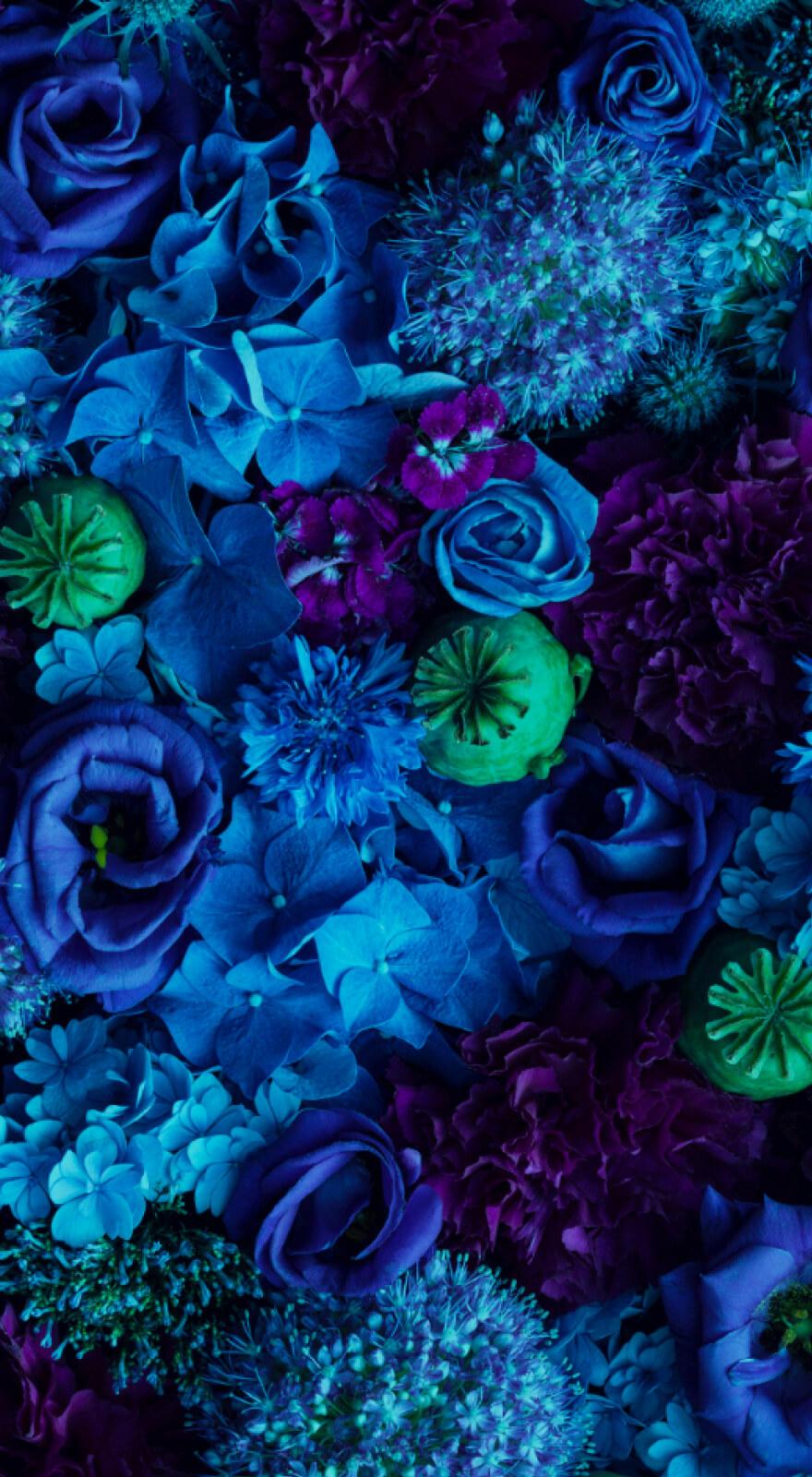Knowde Enhanced TDS
Identification & Functionality
- Ingredient Origin
- Cosmetic Ingredients Functions
- Technologies
- Product Families
- Form
- Cells (20%) in Glycerin or Sunflower Oil (80%)
Features & Benefits
- Benefit Claims
- Labeling Claims
- The lilac fragrant flowers, a precious remnant of the19th century
The scientific name of « syringa » comes from the hollow stem of lilac shoots; despite its small size – 2 to 5 m – this shrub can live for up to 40 years. Originally from the outer reaches of South-Eastern Europe, it made its way into European gardens in the 16th century, when it was introduced to Italy. In the19th century, people liked the fragrant creamy white and purple flowers so much that they were used as decoration inside houses and the French horticulturist Victor Lemoine created numerous lilac cultivars. Regarding medicinal uses, only the tonic and antipyretic effects of its leaves are known. A symbol of love and fertility in Antiquity, lilac is now only used for ornamental purposes.
- Key Points
An active plant cell
Developed to deliver the highest amount of original active molecules.A high tech natural ingredient
Created to preserve and improve the identity and the benefits of a natural product.Total balancing action
Repairs and restores for healthy hair.- Product Benefits Hair Health
Restoring shine and damaged hair
Smoothes away hair scales, reinforces natural protection. Harmonizes hair along its entire length. Restores natural shine.Soothing
Reduces irritation of the scalp and roots.Energizing
Reinforces the production of cell energy in the hair roots.Protective (antioxidant)
Reduces the formation of free radicals, including after exposure to UVB. Prevents damage.To be used in hair products such as mask, serum, balm, etc. In any hair product dedicated to strengthen and repair hair and scalp. Any type of hair, especially damaged hair.
Applications & Uses
- Markets
- Applications
- Application Format
- Hair Care Applications
- Use Level
- Starting at 0.5%
- How it Works
Healthy Shine Lilac: restoring biological balance
In everyday life, many factors can damage hair; making it dull, brittle, and irritated.
Today, we know that this indicates a deterioration of the hair shaft and its cuticle that can be due to several factors, that damage hair at the root. There is also the effect of aging, which results in a decrease in energy creation and in oxidation. Hair dye can
also cause inflammation and oxidation of the scalp and roots, as can repeated washing and mechanical manipulation such as excessive brushing and drying. We should also keep in mind that hair is sensitive to stress, which can lead to irritation. Finally sun and pollution can further increase hair oxidation.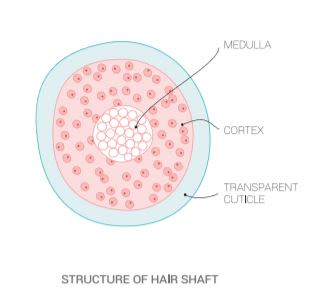
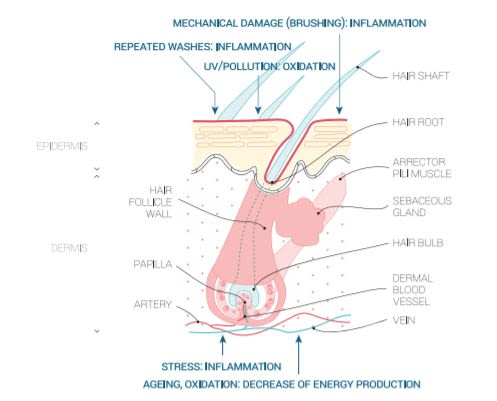
Hair Follicle
Multifunctional action in the heart of the hair follicle
To fight against the harmful effects of all these factors, Naolys proposes a reparative and preventive action in order to restore healthy hair.
Healthy Shine Lilac has a multifunctional effect on hair, acting on all three parts of the hair: the root, the scalp and shaft.
Rebalancing hair at its source
The hair root, the living part of hair, is located in the dermis: it embedded at an angle in the scalp and contains the hair follicle in a little sack. At the base is a “bulb” or hair matrix, that has a small cavity in its lower part, the papilla, where numerous small vessels bring nutrients via the blood and nerve fibers. It is here and on the scalp that imbalances due to environmental and internal factors become apparent.At the level of the bulb and epidermal cells:
Healthy Shine Lilac reduces inflammation at the level of the hair bulb and scalp.
Healthy Shine Lilac reduces oxidation at the level of the hair bulb.
Healthy Shine Lilac increases energy production at the level of the hair bulb.Repairing the hair shaft and cuticle
The visible hair shaft, a very strong filament, is made mainly of keratin, dead cells that have migrated from the root. Its structure consists of three tubular layers one inside the other, the medullar canal in the center, the thick cortex, that produces melanin, and the cuticle that forms an impermeable protective barrier, made of layers of cells arranged in scales. This outer layer suffers mechanical damage on a daily basis.
At the level of the hair shaft: Healthy Shine Lilac repairs and enhances shine.Repaired, soothed, protected, and strengthened by Healthy Shine Lilac, hair will become shiny and healthy again, and will be better protected against damage from the environment and internal factors.
Properties
- Physical Form
Regulatory & Compliance
Technical Details & Test Data
- Clinical Test Results
Hair repaired and shinier in 28 days
The panel’s verdict
- 90% declared that their hair was shinier
- 80% declared that their hair was less damaged
At a concentration of 0.5%
- In Vitro Tests Results
A complete rebalancing of the hair bulb
Energizing effect
Due to an increase in energy metabolism indicated by an increase in ATP synthesis at the cellular and mitochondrial levels.Soothing effect
Due to a decrease of the release of inflammation mediators, IL1-alpha (-25%), IL-6 (-22%) and PGE2 (-20%). And similar decreases at scalp level: IL1-alpha (-28%), IL-6 (-24%) and PGE2 (-23%).Antioxidant effect
Due to a decrease in free radicals indicated by a 20% decrease in the production of endogenous MDA, and a 25% decrease in production caused by UVB.- Clinical Study
Repairing effect on the hair after 28 days
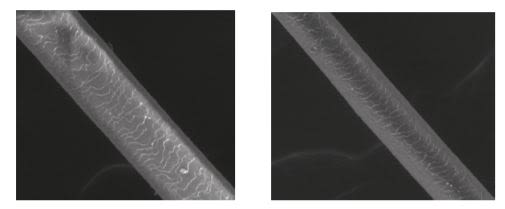
Increased shine after 28 days
Study conditions:
- Testing for 28 days on 20 women aged 20-45 years with black damaged hair
- Application once a day to the entire scalp and hair
- Emulsion with 0.5% of Healthy Shine Lilac
- In Vitro Testing Results
Rebalancing hair at its source
The hair bulb
Healthy Shine Lilac acts on all parts of the hair, from the root to the scales.
Concerning the root and scalp, Naolys decided to focus on the activities essential to maintaining healthy hair both from a preventive and restorative perspective in the hair bulb, i.e. its general metabolism and the regulation of inflammation and oxidation.
The hair bulb refers to the enlarged base of the hair follicle or root. The dermal papilla is at the base of the bulb, where blood capillaries irrigate, nourish and oxygenate the cells in the germinal membraneIn the hair bulb,
Energy
To improve both the energy metabolism required for the birth and development of a healthy hair (i.e. cell multiplication) and disposal of cellular waste, Naolys studied the absorption of oxygen and the speed of ATP synthesis via cellular respiration.Inflammation
To reduce inflammation caused by mechanical manipulation and chemical agents on the hair, which can develop in all parts of the hair follicle, from the scalp to the root, Naolys considered the key inflammation mediators: IL1-alpha, IL-6 and PGE2.Oxidation
Finally, Naolys studied the release of MDA (malondialdehyde), which is produced during physiological and induced lipid peroxidation. Usually endogenous production of free radicals (physiological lipid peroxidation) is counterbalanced by various defense mechanisms. However, many situations can lead to an excess of free radicals (induced lipid peroxidation) such as intense sun exposure, intoxication by certain chemical products (coloring), contamination by toxins (during respiration), and intense inflammatory reactions, etc. which affect the hair. enabling rapid growth in the form of mitosis. At the base of the hair follicle, cells are gradually pushed upwards by the growth of subsequent cells. As the cells rise in the follicle their walls deteriorate, they become longer, keratinized, and move towards the outside, thereby forming the cuticle. As for the cortex, these cells are located above the papilla and have a tapered shape toward the axis of the follicle. It also contains the melanocytes, responsible for melanin synthesis which is transmitted to the keratinocytes. Furthermore, it is at this level that cellular waste is removed.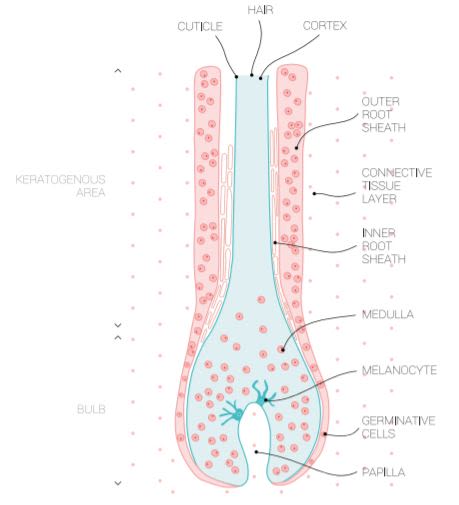
Hair Root
Study of energy metabolism
In the hair bulbAt a concentration of 0.5%, Healthy Shine Lilac in contact with keratinocytes in culture, induces a significant increase in:
- The speed of basal cellular and mitochondrial respiration,
- the speed of cellular and mitochondrial ATP synthesis,
- ATP and ADP cellular synthesis after 5 days in contact with the product.
Study of inflammation mediators In the hair bulb and in the scalp
In the hair bulb
Decrease of IL1-alpha
In reaction of UVB, decrease of the release of inflammation mediator, lL1-alpha respectively by 25%, 31% and 36%.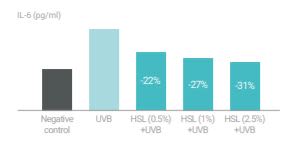
Decrease of IL-6
In reaction of UVB, decrease of the release of inflammation mediator, IL-6 respectively by 22%, 27% and 31%.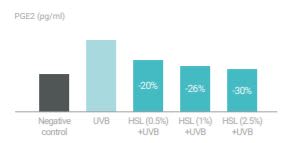
Decrease of PGE2
In reaction of UVB, decrease of the release of inflammation mediator, PGE2, respectively by 20%, 26% and 30%.In the scalp
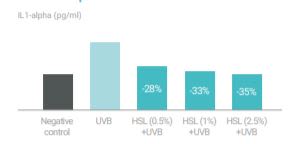
Decrease of IL1-alpha
In reaction of UVB, decrease of the release of inflammation mediator, lL1-alpha respectively by 28%, 33% and 35%.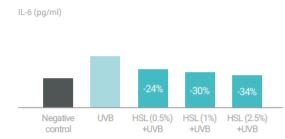
Decrease of IL-6
In reaction of UVB, decrease of the release of inflammation mediator, IL-6 respectively by 24%, 30% and 34%.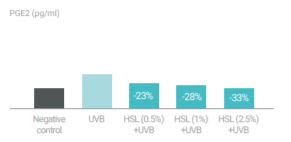
Decrease of PGE2
In reaction of UVB, decrease of the release of inflammation mediator, PGE2, respectively by 23%, 28% and 33%.Study of lipid peroxidation
In the hair bulbPhysiological lipid peroxidation
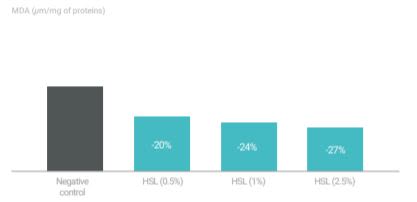
Decrease of MDA rate
At concentrations of 0.5%, 1% and 2.5%, decrease in the release of MDA rate respectively by 20%, 24% and 27%.Lipid peroxidation induced by UVB
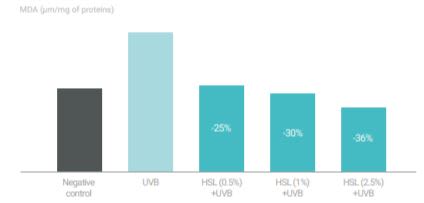
Decrease of MDA rate
At concentrations of 0.5%, 1% and 2.5%, decrease in the release of MDA rate
respectively by 25%, 30% and 36%.
Packaging & Availability
- Regional Availability
